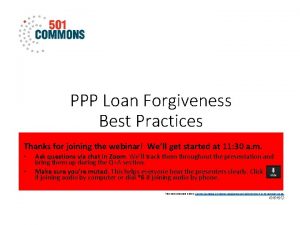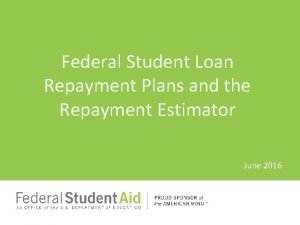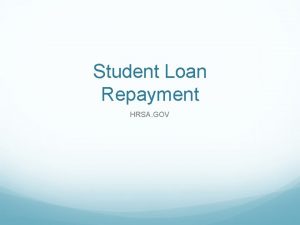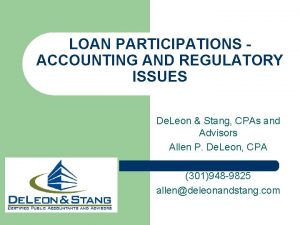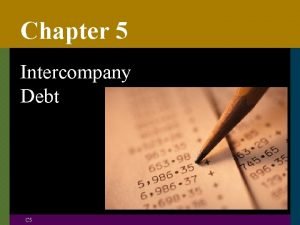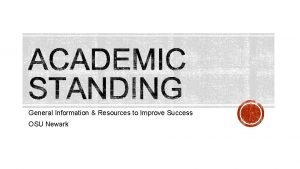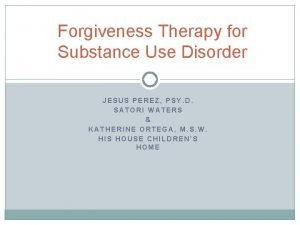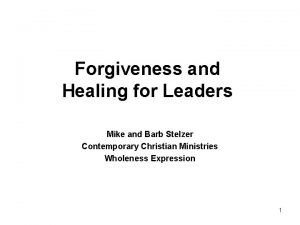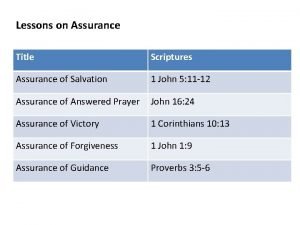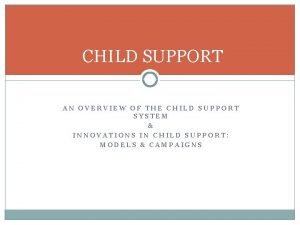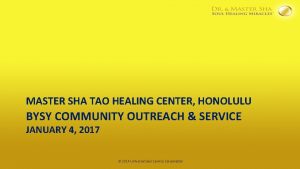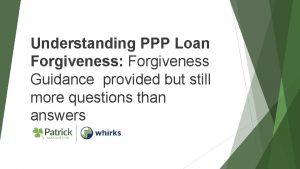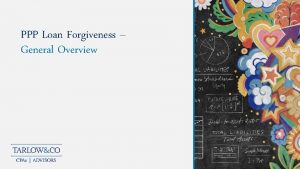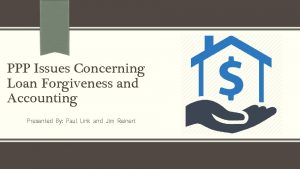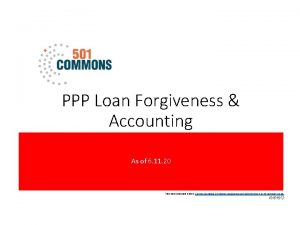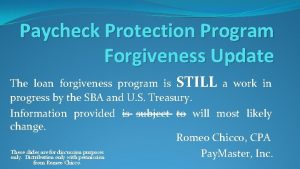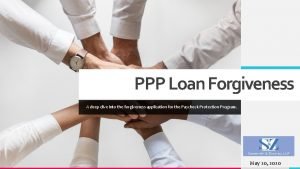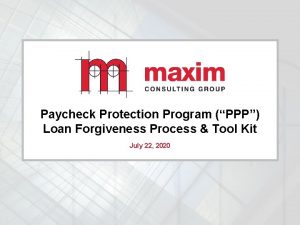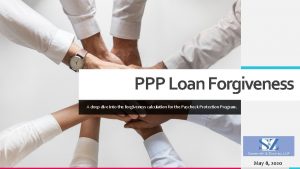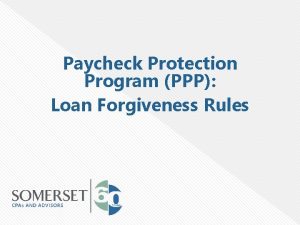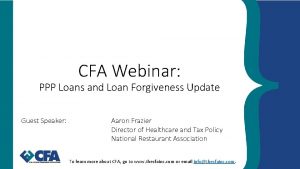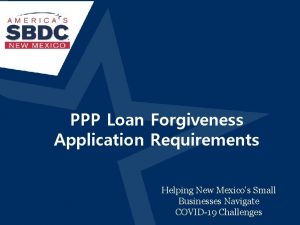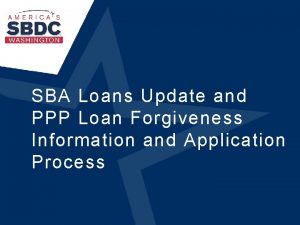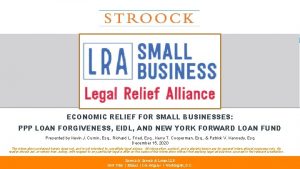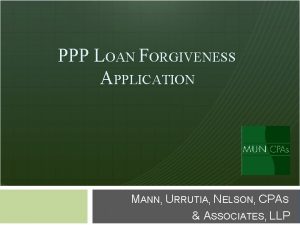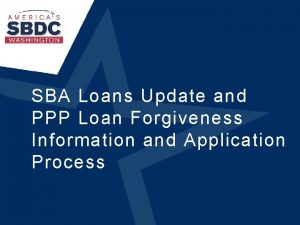PPP Loan Forgiveness Accounting As of 6 11



























- Slides: 27

PPP Loan Forgiveness & Accounting As of 6. 11. 20 This work is licensed under a Creative Commons Attribution-Non. Commercial-No. Derivatives 4. 0 International License.

PPP Loan Forgiveness Best Practices • As of 6. 11. 20, the SBA had not released any final guidance on PPP Loan Forgiveness. • The best recommendations we can make as of this writing are: • To follow the guidelines set forth so far by the US Department of Treasury and SBA • To keep a separate bank account for the PPP Loan • Prepare for the possibility of repaying a portion of the PPP Loan from the beginning • To document every PPP loan-related transaction Disclaimer: The recommendations that 501 Commons makes in this document are based on what we know as of 6. 11. 20. 501 Commons can make no guarantee that the information will not change, potentially materially, in the coming days as regulating bodies such as the SBA and U. S. Department of Treasury release guidance on the forgiveness of the PPP Loan. This information is intended solely to give our best recommendations as of the date of publication. Any decisions you and your organization make are at your own discretion.

PPP Forgiveness Best Practices- Banking • While it is not a requirement for you to keep a separate bank account for the PPP Loan, we recommend it. • Why a separate bank account? : • Keeping a separate bank account allows you to more clearly see the loan funds and to match them directly to a tracking document, such as the 8 -Week PPP Loan Forgiveness Tracker. • Where possible, you should use your general account to pay all expenses as you normally would and then make a transfer of funds from the loan account to your general account to match your tracking document.

PPP Loan Forgiveness Best Practices- Guidelines • Guidelines from the U. S. Department of Treasury: • The following will reduce loan forgiveness: • Loan funds uses: Using the loan funds - during the 24 weeks* after getting the loan - for anything other than payroll costs, mortgage interest, rent, and utilities payments. • Percentage of non-payroll costs: Spending more than 40% of the loan in the 24 weeks* after receiving the loan - on mortgage interest, rent, and utilities costs. • Number of staff: Decreasing your full-time employee headcount. • Level of payroll: Decreasing salaries and wages by more than 25% for any employee that made less than $100, 000 on an annualized basis in 2019. • Re-hiring: You have until December 31, 2020 to restore your full-time employment and salary levels if you made any changes between February 15, 2020 and April 26, 2020. • *If you already have a loan, you may opt for the original 8 week period

Updates from the Paycheck Protection Program Flexibility Act • Extending the loan covered period from 8 weeks to 24 weeks or December 31, 2020 whichever comes first. If you already have a PPP Loan, you can use the original 8 -week period. • Extending the safe harbors for restoration of wages and fulltime equivalent workers from June 30 to December 31, 2020 • Reducing the minimum required spending on payroll costs from 75% to 60%

Updates from the Paycheck Protection Program Flexibility Act • Creating new safe harbor provisions to remove the FTE reduction in forgiveness. To do so, borrowers would need to document: • The inability to rehire individuals who were employees on February 15, 2020 and the inability to rehire similarly qualified individuals on or before December 31, 2020, OR • The inability to return to the same level of business activity from February 15, 2020 due to compliance with guidance or requirements issued by government agencies (see the act for list) from March 1 December 31, 2020 relating to sanitation standards, social distancing or any other worker or customer safety requirement related to COVID-19

Updates from the Paycheck Protection Program Flexibility Act • Extending the loan maturity from 2 years to 5 years • Requiring borrowers to request forgiveness within 10 months of the last day of their covered period or payments would begin at that time • Deferring the principal and interest payments until the SBA remits the loan forgiveness amount to the lender

Updates from the Paycheck Protection Program Flexibility Act • While these changes will be beneficial to organizations and will make it easier to use the entirety of the PPP loan funds, it is important to remember that the SBA will still need to create new regulations (Interim Final Rules etc. ) in order to apply the new changes. This could mean that new versions of the application forgiveness will take some time to see. For reference, the CARES Act became law on March 27 and the application first came out on May 15, with the important Interim Final Rules related to forgiveness appearing on May 22.

The Paycheck Protection Program Flexibility Act Questions That Remain • The new Act creates a great number of questions, for which we still need further guidance • Do you have to maintain your FTE and salary levels now for the entire 24 weeks? • Can you use the PPP Loan funds to extend more broadly over the 24 week period even if that means you cannot maintain the same level of FTE and salary from 2. 15. 20 and still seek forgiveness? • Will individual employees still be limited to $15, 385 now that the period has shifted from 8 weeks to 24? • How long will it be before we see an online application from our lender?

PPP Loan Forgiveness: 8 or 24 Weeks? 8 weeks may benefit you more if: 24 weeks may benefit you more if: You were able to spend at least 60% of loan on allowable payroll costs during your 8 -week period You need additional time to spend the loan funds and meet the required 60% on allowable payroll costs You are unable to maintain your current FTE or salary levels for a full 24 weeks The PPP Loan helped offset the burden on your cash reserves and other revenue sources, but is not the sole factor in whether you maintain your FTEs and salary levels from 2. 15. 20 Your organization is not able to maintain the amount of tracking required in the long term The longer time period will allow you the opportunity for greater forgiveness

PPP Loan Forgiveness: 8 or 24 Weeks? • Remember that it was always possible to continue spending the PPP loan funds on allowable costs after the 8 -week period • So consider whether it would be prudent to simply continue using the PPP loan funds after your original 8 -weeks even if this means that last portion may convert to a loan due in 5 years at 1% interest • Breathe: • Nothing is due in the immediate term and is unlikely to be • Given how the PPP has been, it is also likely to continue to change as additional guidance is released

PPP Loan Forgiveness Best Practices- Timing • The loan period begins upon the disbursement of funds from the lender to the organization’s bank account. (see Treasury guidance point 20 of the US Department of Treasury PPP FAQs as of 5. 19. 2020) • However, as of 5. 15. 20, you now have the option of choosing an Alternative Payroll Covered Period (APCP) starting on the first day of your regularly scheduled next payroll if they are on a bi-weekly schedule or sooner. This option relates to payroll covered costs only. • From the Application: Payroll costs are considered paid on the day that paychecks are distributed or you originate an ACH credit transaction. Payroll costs are considered incurred on the day that the employee’s pay is earned. Payroll costs incurred but not paid during the Borrower’s last pay period of the Covered Period (or Alternative Payroll Covered Period) are eligible forgiveness if paid on or before the next regular payroll date.

PPP Forgiveness Best Practices- Double Dipping • If you are receiving other federal funds, you cannot "double dip, " meaning you cannot claim to the federal government you spent different federal funds on the same expenses. You should consider comparing your allowable expenses for the PPP vs. federal grants and contracts. There may be other allowable expenses that an organization’s other federal funding can cover, including during the 8 -week period. • On the subject of double-dipping: You may have received non-federal grants that pay for wages. We recommend that you contact your grantors about this topic for the loan period where wages are covered by PPP, especially if it’s a reimbursable grant (some grants give a monthly amount no matter how the funds are spent). • Many Grantors do not specify when grant funds need to be expended. So, it is possible that you could utilize these grant funds after your 8 week covered period to avoid double dipping.

PPP Forgiveness Best Practices-Families First Coronavirus Relief Act Wages • Organizations cannot include wages paid underneath other provisions of the Families First Coronavirus Relief Act (Paid Sick Leave and the Expanded Family Medial Leave Act). • Please see this information from the National Council of Nonprofits for more information on the FFCRA provisions.

PPP Loan Forgiveness Formula Add Payroll Costs Subtract Wages for FFCRA, other tax credits or grants Add Non-Payroll Costs Subtract >25% Salary/Wage Reduction Multiply by FTE Quotient Equals Modified Total

>25% Salary Reduction Test • Pending further guidance, we are assuming that this test will remain relatively unchanged • On a per employee basis for employees who received compensation at an annualized rate of less than or equal to $100, 000 for all pay periods in 2019, or you did not employee at any point in 2019, calculate the following: • Compare average annual salary/hourly wage between your Covered Period (CP) or Alternative Payroll Covered Period (APCP) to the average annual salary/hourly wage from January 1 -March 31, 2020. • If the reduction is more than 25% you will compare the annual salary/hourly wage as of February 15, 2020 to the average annual salary/hourly wage between February 15 -April 26, 2020. • You will then compare the average annual salary/hourly wage from December 31, 2020 to the average annual salary/hourly wage from February 15, 2020. If the number from December 31 is equal to or greater than February 15, the safe harbor will have been met.

>25% Salary Reduction Test • If the safe harbor is not met, you will calculate the reduction in your forgiveness amount. • As a baseline you’ll use the average annual salary/hourly wage from January 1 -March 31, 2020 and multiply it by. 75. • You’ll subtract this from the annual salary/hourly wage as of February 15, 2020. • For hourly workers, you’ll take the average hours from January 1 - March 31, 2020 and multiply it by the 75% amount you calculated and then multiply by 8. • For salaried workers, you’ll multiply your 75% amount by 8 and then divide by 52.

>25% Salary Reduction Test (Hourly Worker) 1 a. Average Hourly Wage CP/APCP $20 1 b. Average Hourly Wage from 1. 1. -3. 31 $30 1 c. (1 a. /1 b. >=75%)? 2 a. Annual Hourly Wage as of 2. 15 67% (NO- So, Safe Harbor Test Required) $30 2 b. Average Hourly Wage from 2. 15 -4. 26 $25 2 c. Average Hourly Wage as of 6. 30. 20 (>=2 a? ) 3 a. (1 b. x. 75) $25 (NO- Complete Salary Reduction Calculation) $22. 50 3 b. (3 a. -1 a. ) $2. 5 3 c. Average number of hours worked between 1. 1 40 -3. 31. 20 3 d. (3 b. x 3 c. x 8) $800

>25% Salary/Hourly Wage Reduction Tool • The >25% Salary/Hourly Wage Reduction Tool is now divided into 8 week and 24 -week version. You should choose the tool that matches the period your organization chooses.

FTE Reduction Quotient • Pending further guidance, we are assuming this test will remain relatively unchanged • You now have two ways of calculating FTE (remember this is NOT headcount, which you were asked about during the application) • You can now choose to use a standard FTE calculation out of 40 hours or • You can choose a simplified method where everyone working 40 hours and over is 1 and anyone working under this is. 5 • Don’t worry, you can utilize the FTE Quotient Estimator to help you see this more clearly!

FTE- Start with FTE for your CP or APCP Employee Average Paid Hours per Week during CP or APCP Average FTE Simplified Average FTE Employee A 40 1 1 Employee B 30 . 75 . 5 Employee C 20 . 5 2. 25 2 Total

FTE- Comparison Periods • You can choose between two comparison periods: • February 15 -June 30, 2019 or • January 1 -February 29 2020 • You will want to choose the lower of the two numbers as it will compare best to your CP or APCP.

FTE- Comparison Periods Average FTE Simplified Average FTE CP/APCP 2. 25 2 January 1 -February 29, 2020 3. 25 3 4 3. 5 February 15 -June 30, 2019 • In both methods, the lower number come from the January 1 -February 29, 2020 period

FTE Quotient Calculation Average FTE Simplified Average FTE 2. 25 2 Chosen Reference Period (January 1 -February 3. 25 29, 2020) 3 Divide CP/APCP by Reference Period >75%? If NO, then Safe Harbor Test 67% or. 67 CP/APCP 69% or. 69 • Here we choose the higher of the two in order to maximize your forgivable amount

FTE Safe Harbor Test Average FTE Simplified Average FTE as from February 15 -April 26, 2020 2. 25 2 Total FTE during the pay period including February 15, 2020 3. 25 3 Is Row 2 Greater than Row 1? Yes Total FTE as of December 31, 2020 3. 25 3 If Row 4 is greater than Row 2, Safe Harbor test has been met and your quotient is 1 1 1

FTE Quotient Tool • The FTE Quotient tool has been updated • So far, this test shows little sign of changing. • We are waiting for clarifications

PPP Forgiveness Best Practices- Applying for Forgiveness • At the end of the forgiveness period, which is now assumed to be 24 weeks unless you already had a PPP loan, borrowers must apply forgiveness through their lender. • At this time, we do not have a full picture of what the forgiveness application will entail, but you should plan to be able to present documentation related to payroll, payroll taxes and all expenses you are planning on having forgiven. • The process will also likely include an application forgiveness and attestations and certifications. • The lenders we are working with, expect that it will still be some time before you can apply, so continue to stay in contact with your lender and be patient with them.
 Ppp loan forgiveness
Ppp loan forgiveness Nebraska teacher loan forgiveness
Nebraska teacher loan forgiveness Hrsa student loan forgiveness
Hrsa student loan forgiveness Ppp loan list
Ppp loan list Accounting for loan participations
Accounting for loan participations Intercompany loan accounting entries
Intercompany loan accounting entries Enright forgiveness model
Enright forgiveness model Osu!
Osu! Chapter 6 sin and forgiveness answers
Chapter 6 sin and forgiveness answers Talk on forgiveness
Talk on forgiveness Everyone needs forgiveness the kindness of a savior
Everyone needs forgiveness the kindness of a savior Why does the giver ask jonas for forgiveness
Why does the giver ask jonas for forgiveness Phases of forgiveness
Phases of forgiveness Scriptures on forgiveness
Scriptures on forgiveness Forgiveness vs reconciliation
Forgiveness vs reconciliation Matthew forgiveness
Matthew forgiveness What is to forgive
What is to forgive 2 samuel 13 esv
2 samuel 13 esv Lessons on assurance
Lessons on assurance Fau academic calendar
Fau academic calendar Theme of forgiveness in long day's journey into night
Theme of forgiveness in long day's journey into night Maryland child support arrears forgiveness
Maryland child support arrears forgiveness God's forgiveness
God's forgiveness Joseph forgives
Joseph forgives Child support arrears forgiveness letter missouri
Child support arrears forgiveness letter missouri Tao healing center
Tao healing center Joseph and forgiveness
Joseph and forgiveness Fgcu grade forgiveness
Fgcu grade forgiveness
